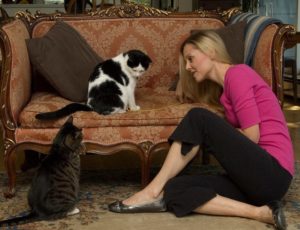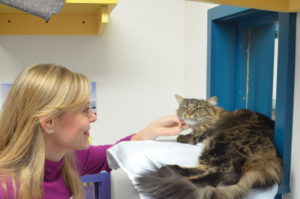We are excited to offer new feline handling webinars by noted animal behaviorist Alana Stevenson. Alana has been helping dog and cat owners resolve their pets’ behavioral problems since early 2003. She is certified in Low Stress Handling for Dogs and Cats, is on the Cat-Friendly Practice Advisory Council for the American Association of Feline Practitioners, and is the author of two books on humane dog training and behavior modificatio: The Right Way the First Time: Teaching Your Dog Kindly & Humanely (2007) and Training Your Dog the Humane Way: Simple Teaching Tips for Resolving Problem Behaviors and Raising a Happy Dog (2011). Dr. Sally Foote recently sat down with Alana to talk about the new webinars which focus on basic low-stress handling techniques for cats.
Dr. Foote: Alana, tell us a bit about yourself. How did you become an animal behaviorist with a focus on feline behavior?
Alanna Stevenson: My path to becoming a behaviorist was not a direct one. In high school, for two years, I worked at a veterinary clinic. I began my education in college with a bachelor’s degree in biology (although I originally wanted to major in marine biology and work with marine animals), and then my working career as a high school science-biology teacher. I ended up taking a full-time internship in canine behavior and was mentored by a few trainers. Part of that curriculum was Dr. Overall’s Clinical Behavioral Medicine in Small Animals. In my journey, I became certified with a number of professional associations, as well as in various handling programs, including the Low Stress Handling® Certification program. I found that teaching helped me easily convey knowledge to others, as well as helped them to apply that knowledge, which has helped tremendously with clients and speaking.
I love kitties and am obsessed with them, and have always had them, so I devoured all that I could find on feline behavior. There was not much published, especially academically. Since I was applying learning theory to all of my dog clients, it was a natural extension to do this for cats also, especially when you know how to read their body-language and are familiar with the species.
My connection with shelter advocacy and rescue work led me to manage the behavioral department for a very large animal shelter. From this I worked with the executive director of the American Association of Feline Practitioners in creating guidelines and developing an SOP on humane feline handling and care for animal shelters. I currently am a house call behaviorist, helping people resolve their dog’s and cat’s behavioral problems (and have been doing so for nearly 17 years). I am a speaker on animal behavior, and author of books on dog behavior.
Dr. Foote: You brought up some points about how applying behavioral science helps you work with your clients on creating behavior solutions for pets in the home. Would you elaborate on this?
AS: I found working one-on-one with my clients in the home enabled me to point out the multiple factors that were contributing to behavior problems. Simple environmental modifications made to the home, especially for cats, can improve behavior significantly. It’s also helpful to notice the interactions between the owner and the cat, as these interactions can change the outcome of behavior problems. It’s important to have a strong base of knowledge in reading body language and I teach owners how to read their cat’s body-language, so they have a better understanding of their cat.
Dr. Foote: You have created a webinar series, Feline Fundamentals, Low Stress Handling Basics, Part(s) 1 and 2, for Low Stress Handling® University. What will people learn from these presentations?
AS: In Feline Fundamentals, Part 1, I go over how our approach and attitude matters when handling cats and the importance of using humane, gentle techniques. Viewers will learn how to read the body-language of happy, content cats as well as stressed, fearful ones, and some very easy and simple environmental changes that can be made when housing cats to keep them calmer and more relaxed. This is especially helpful in shelter settings.
In Feline Fundamentals, Part 2, viewers learn specific low-stress handling techniques, how to use towels to keep cats calm, and why they should avoid scruffing. I demonstrate how to safely and gently pick up, hold, and carry cats, as well as how to transfer them into and out of cages and carriers.
What I saw working at a shelter, and from my own experience with clients, is that many wonderful people including volunteers want to work with cats in a less stressful way and do care about them, but they don’t have the correct behavioral tools or techniques, nor information to know how to handle cats in ways to prevent stress. My webinars will also educate the veterinary staff, yet I have kept the presentation approachable and informative for those who do not have a veterinary background, so they can apply these humane handling principles to real-life situations, especially in shelter settings and rescue.
Dr. Foote: You bring up an excellent point, in that there is a large variation in the knowledge base for those people caring for cats, especially outside of the veterinary setting. Home pet sitters, who may not be veterinary technicians, often need to give insulin injections or sub-cutaneous fluids. Rescues giving the first exam or assisting for vaccine clinics may be handling multiple cats every moment. What specific handling techniques do you hope to change?
AS: I’d like to stop the scruffing of cats. That one technique creates a lot of stress and is unnecessary. It also creates a disconnect between the handler and the cat. It is so automatic and the go-to for many, but I want the viewer to stop and assess the cat using a gentle approach and to use alternative techniques such as the towel wraps rather than just go straight to scruffing.
Dr. Foote: I agree completely! I really like the various videos that demonstrate correct approach and alternative techniques in your presentations. I have witnessed that traditional handling techniques trigger anxiety and aggression in both home care and shelter care. What do you think is the best way to implement these changes once people take your webinars?
AS: My hope is each person taking the webinars will use and apply what they learn, and then by example, will teach others, and then others will follow. Pet sitters and others who work with cats can help their clients learn less stressful ways to provide care for their cats as well. Overall, it’s important that those people who work with cats and handle them on a regular basis, especially without a veterinary background, have easily accessible information and relevant applicable tools to humanely handle cats to enhance feline welfare. Shelter and rescue staff may handle and work with hundreds of cats a day. And these cats come from all background and situations. And often these cats are stressed. It’s important for those who care about cats to have this information easily accessible to them.
Dr. Foote: If someone wanted to follow you, contact you, get your SOP for shelter care how would they contact you?
AS: They can go to my website alanstevenson.com and contact me through the site. I’m happy to answer questions and they can call on the phone.
Dr. Foote: thank you for creating these webinars, and for building on the foundation of Low Stress Handling,® and helping cats have a better care experience.
AS: You are welcome!
You can find Alana’s Feline Fundamentals webinars, as well as other online courses in Low Stress Handling® techniques, here.




